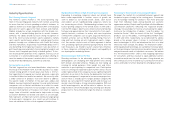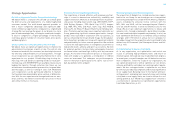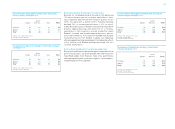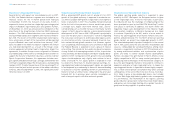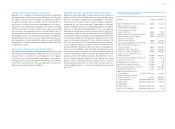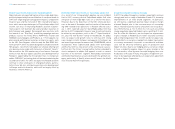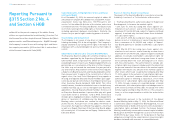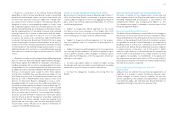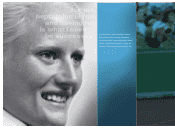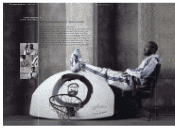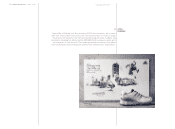Reebok 2006 Annual Report Download - page 116
Download and view the complete annual report
Please find page 116 of the 2006 Reebok annual report below. You can navigate through the pages in the report by either clicking on the pages listed below, or by using the keyword search tool below to find specific information within the annual report.Group Management Report ›› Subsequent Events and Outlook
Working Capital Management to Improve Balance Sheet
Operating working capital management is a major focus of
our efforts to improve the Group’s balance sheet (see Internal
Group Management System, p. 48). Our goal is to reduce oper-
ating working capital as a percentage of net sales to 25% or
lower in 2007. Inventory management in particular will be an
important mechanism for the realization of further improve-
ments. Optimizing inventory levels for fast replenishment
and rigorous control of inventory ageing are the priorities for
our Working Capital Task Force in 2007. We will also look to
extract further improvement in accounts receivable, improv-
ing collection efforts and optimizing payment terms with our
suppliers to best manage our accounts payable.
Investment Level Between € 300 Million and € 400 Million
In 2007, investments in tangible and intangible assets of
between € 300 million and € 400 million within the adidas
Group will be used primarily for own-retail expansion at
brand adidas as well as the increased deployment of SAP and
other IT systems in major subsidiaries within the Group. In
emerging markets, own-retail expansion of the Reebok brand
will also begin to play a more significant role. Expenditure per
brand will be roughly in line with our sales split, while some
capital expenditure will be related to the further expansion
at adidas Group headquarters in Herzogenaurach, Germany.
The most important factors in determining the exact level
and timing of the investment will be the rate at which we are
able to successfully secure retail locations and integrate new
SAP systems within existing applications. All our investments
will be financed through cash generated in our operating
business.
Free Cash Flow to Drive Reductions in Net Borrowings
We intend to further reduce our net borrowings in 2007 to
below € 2 billion through continued strong free cash flow gen-
eration and tight working capital management. At the begin-
ning of 2006, our net borrowings position increased signifi-
cantly as a result of our acquisition of Reebok International
Ltd. (USA). In 2007, we will generate at least € 200 million to
€ 300 million in free cash flow, and we see the potential to
increase this level in subsequent years. Further, we are well
on track to achieving our medium-term target of financial
leverage below 50%. Due to the strong cash generation from
our operating activities, which enables us to fully meet our
financing requirements, we do not plan any significant financ-
ing initiatives in 2007.
Dividend Payout Increases 29%
Although debt reduction continues to be a priority, we are
committed to maintaining the Group’s recommended long-
term, earnings-linked dividend payout ratio corridor of
between 15 and 25% of net income. At our Annual General
Meeting on May 10, 2007, we intend to propose a dividend
of € 0.42 per share for the 2006 financial year. As a result,
the dividend payout will increase 29% to € 85 million (2005:
€ 66 million), outpacing earnings growth for the year. This
represents a payout ratio of 18% (2005: 17%) and shows our
confidence in the Group’s future business performance.
Medium-Term Revenue Synergies from Reebok Integration
We have an ambitious target to generate at least € 500 million
of incremental revenue by 2009 related to the Reebok inte-
gration through specific initiatives that include:
» Branded apparel: We expect to deliver € 100 million from
leveraging adidas’ industry-leading branded apparel know-
how to strengthen and expand Reebok’s branded apparel
efforts.
» Licensed products: At brand adidas, we expect to gen-
erate € 100 million of additional sales in licensed products.
By transferring the NBA contract to adidas we can further
exploit this exclusive relationship more effectively, particu-
larly outside of North America. Also, further opportunities
exist for other adidas licensed product particularly in North
America from utilizing Reebok’s on-field sales and production
capabilities.
» Regional initiatives: We expect € 100 million of incremen-
tal revenue synergies from greater regional traction in Europe
and Asia. This will result from tighter coordination of Reebok
product category initiatives in underdeveloped markets with
the strong adidas infrastructure.
» Distributor buyouts: We project € 200 million in incremen-
tal sales synergies through exercising more control over the
Reebok brand around the globe, particularly in high growth
markets in Asia and Emerging Europe. This will be achieved
by buying out distributor and joint venture partners.
Our goal is to deliver these synergies in the following timeline:
€ 100 million in 2007, € 250 million in 2008 and € 500 million
in 2009. The costs associated with achieving these synergies
are minimal. With the exception of distributor buyouts, which
will be classified as investments versus operating expenses,
we currently estimate one-time expenses associated with
all revenue synergies to average between € 15 million and
€ 25 million annually between 2007 and 2009.
112 ANNUAL REPORT 2006 › adidas Group ›




